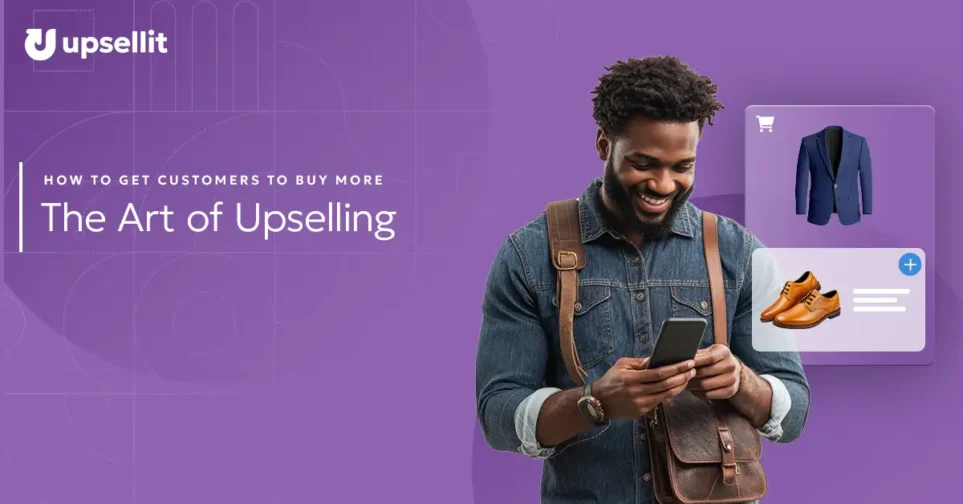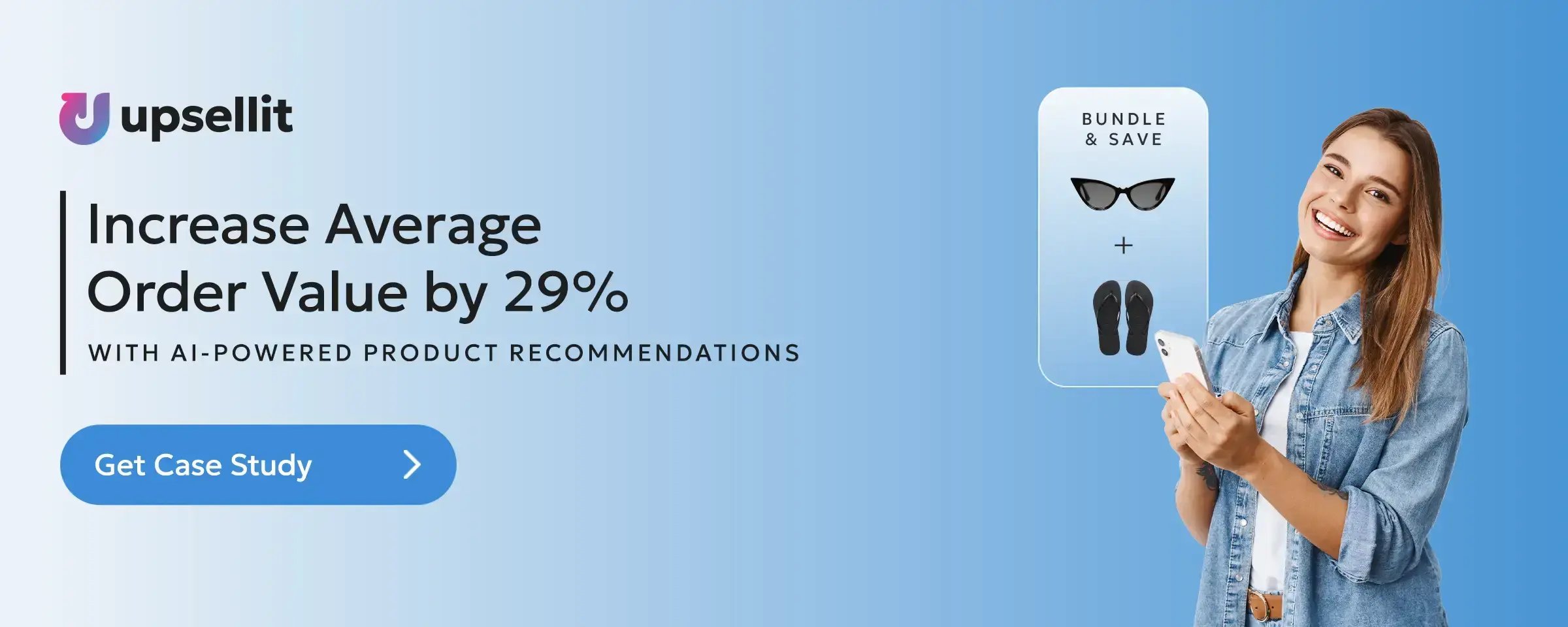What is an Upsell?
Few sales techniques are as universal and effective as upselling. For the uninitiated, the definition of upselling is offering an upgraded, premium, or improved version of a product or service to increase the value of a purchase.
Upselling exists because customers will often pick the least expensive version of whatever they’re buying. In general, consumers will only spring for a higher priced option if they see a direct benefit to paying more.
It is a salesperson’s job to make the customer aware of options beyond what they intended to purchase. In the case of ecommerce, upselling typically involves the use of dynamic product recommendations and other onsite tools.
The Difference Between Cross-sells and Upsells
Upselling and cross-selling are frequently confused with one another. While this is understandable, both raise average order value in different ways. To put it simply:
- An upsell offers a premium version of a product
- A cross-sell offers additional products or services
Let’s take a look at a quick example of both techniques.
Example Scenario — A customer in a cafe orders a small coffee.
- Upsell: The barista asks if they’d like to make it a medium for 25¢ more.
- Cross-sell: The barista asks if they’d like a bagel with their coffee.
Reaping the Benefits of Upselling
Now that we’ve discussed what upselling is, let’s talk about what makes this technique so useful and important in ecommerce.
Increased AOV + Revenue
Upselling is one of the simplest methods for increasing your revenues and AOV. First of all, upselling doesn’t require any form of capital investment. Upselling is an expense-free way to increase average order value and grow your business.
Furthermore, upselling is virtually risk free. While it’s likely that some shoppers won’t convert on the more expensive product, your site has lost nothing by suggesting the higher-priced option. It’s like the old adage says “If you don’t ask, the answer’s always no.”
Personalized Experiences
Upselling is about giving users options. While some sites assume that shoppers may be bothered by upsells, on the contrary, shoppers generally like having multiple buying options.
Many shoppers enter an online shopping experience with minimal information on the product they’re interested in. By offering the upsell, you’re actively helping customers discover more about the product they’re interested in.
Build Trust + Loyalty
Shoppers like it when online stores are upfront and honest about what a product offers. By nature, upsells involve breaking down the strengths of a product along with the price associated with each option.
When you’re honest with customers about what a product can do at each price point, it provides good customer service, building trust and rapport. Over time, this can develop into customer loyalty.
How to Upsell in Ecommerce
Now, let’s take a look at upselling in action, and how your site can take advantage of this technique.
1. Emphasize Premium Benefits
If you want a customer to purchase the highest quality (and most expensive) version of your product, it’s important for them to understand why it’s worth the extra money.
For instance, one of the most common upsells people encounter on a regular basis is at fast-food restaurants. Combo meals are generally available in more than one size, and can be “upgraded” for a small fee. In this case, the benefits of paying more for the meal are very clear: the customer gets more food.

The same should be true when you upsell your customers. Make sure they see a direct benefit to paying more. If possible, list the benefits of the more expensive version in plain english. Try picking the top 3 reasons that this product is worth it, and run with them.
One strategy for demonstrating the value of premium benefits is using social proof. Highlight reviews that specifically speak to why the product you’re recommending is worth paying more for. If you need to generate more reviews, this is a great time to create a post-purchase lifecycle email marketing campaign.
Applying This to Ecommerce
Now, let’s look at how we can apply these concepts in ecommerce. Let’s say your site sells phone cases, and offers two popular models, one priced at $20 and one priced at $30.
Both cases protect against drops, but the $30 case has the additional benefit of being waterproof.
If a shopper adds the $20 case to their cart, you can run an on-site engagement that attempts to upsell them to the $30 version.
How would you use copy to communicate the benefit of paying more?
- Bad copy: Wait! Spend an Extra $10 for a Better Case!
- Good copy: Wait! Upgrade to Our Waterproof Model for Just $10 More!
The first example is not only poorly worded, it doesn’t tell the shoppers what the actual benefits of upgrading are. It just says the other case is “better.” To reiterate, a successful upsell should explain clearly why the shopper should pay more, rather than just encouraging them to do so.
2. Ensure Relevance
One of the best ways to upsell customers is through a product recommendation engine. Using artificial intelligence, these tools examine purchase history, browsing behavior, and viewed product pages to predict which of your products a shopper is most likely to buy. Among the many capabilities of this technology, it fully automates the upselling process.

While upsells have the power to be very effective, every shopper is different, and some respond to this strategy better than others. Fortunately, key indicators from browsing behavior and past purchases can help you in understanding your customers and identifying upsell opportunities.
For example, browsing behavior can reveal key insights about different shopper types:
- Quality-over-Value Shoppers – If a shopper is consistently looking at new arrivals or has frequently bought full-price items in the past, they are likely less interested in scoring a deal and more focused on purchasing newer, cutting-edge products.
- Deal-Seeking Shoppers – If a shopper heads straight for the sale page or has a history of buying mostly clearance items, it’s wise to adjust your strategy as they are likely more interested in discounted items or bundled offers rather than premium products.
For quality-over-value shoppers, upsells are a fantastic tool for personalizing their experience and showing them the very best you have to offer. For deal-seeking shoppers, cross-selling discounted products or bundled offers provides a more effective alternative to upselling, enhancing their experience by reinforcing the value they prioritize.
By understanding these behaviors, you can ensure that upsells are presented to the right shoppers while tailoring your approach for those who are more price-conscious.
3. Focus on Creating Value
While the goal of successful upselling is to get shoppers to spend more, upsells should ultimately create value for the customer. While you obviously would prefer that everyone took advantage of the upsell, some users won’t – and it’s important not to let that negatively impact their experience.

Avoiding Pushy Upsells
Upselling sometimes gets a bad rap because it can be used in a way that seems pushy. While badgering a customer into buying the more expensive option may eventually get some of them to buy in once, it reduces the likelihood of the customer returning.
To ensure a positive customer experience:
- Present the upsell as an option, not a requirement.
- Find a balance between persuasion and pressure.
- Emphasize the value of the upsell without diminishing the quality of the original item.
How This Applies to Ecommerce
For a moment, let’s go back to the phone case example, in which the shopper has a choice between a basic $20 model and a $30 waterproof model. The copy we came up with was:
“Wait! Upgrade to Our Waterproof Model for Just $10 More!”
This method presents the benefit of the upsell (water protection), the value added by the upsell (small price for the upgrade) while not coming across as overly pushy.
However, this same upsell could easily go bad if we changed the friendly copy to something like:
“Wait! This case offers no waterproofing protection. By proceeding with this purchase, you acknowledge your phone could easily be destroyed.”
Although this is an extreme example, it’s illustrative of how off-putting aggressive upselling can be. Upsells like this make the basic product seem essentially worthless, which isn’t true. Some people simply don’t care if their case is waterproof, and trying to scare them into upgrading can quickly devolve into a bad experience.
This is why finding the right balance is critical.
Striking the Right Balance
Poor user experiences reduce conversion rates and devastate customer loyalty. The end result of upsells should be happy customers who feel like they’re getting a good value, regardless of whether they took the upsell or not. By finding a balance between persuasiveness and customer care, you’ll find a happy medium that leaves everyone satisfied.
The Art of Upselling
Upselling is a fantastic way to increase your average order value. However, like any tool, it must be used thoughtfully. By leveraging a combination of common sense, clever copy, and technology, customer satisfaction can rise along with your AOV.
Looking For More Ways to Increase Your Conversions?
Mastering the art of upselling is just one way to optimize the shopping experience and increase revenue. Upsellit’s AI Recommendations Case Study explores how dynamic, data-driven product suggestions help brands present the right upsell opportunities at the right time. Download it today to see how brands are leveraging AI-powered recommendations to drive higher conversions.

